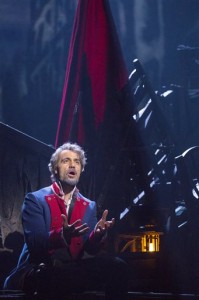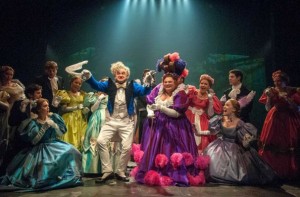By Blaire Diezel
Correspondent
“Les Misérables,” the beloved novel by Victor Hugo, has returned to its home at the Imperial Theater after its departure from Broadway in 2003 (not counting the 2006-2007 revival when the show took residence at the Broadhurst Theater).
With this revival comes some new changes for those who have not seen the show in quite some time. The set design by Matt Kinley is taken from the recent tour that visited theaters across the U.S. and Canada from 2010 to 2013. The design was inspired by paintings of Victor Hugo himself and features projections of Hugo’s artwork during points of the show. A particularly noticeable example is the gray backdrop of the Parisian sewer system during “Dog Eats Dog.” Not only are these choices of backdrop striking, they are also appropriate and fit organically into the show.

However, the striking set design is not the only element that adds to the impact of the performance of the whole. The show’s original 27-piece orchestra has been condensed slightly into a 20-piece orchestra with significant changes in the show’s orchestration. The changes in some orchestrations give the show a richer timbre despite the reduced orchestra size. The musicians of the pit are truly masterful and give the music (composed by Claude-Michel Schönberg and Alain Boublil) a solidified place in musical theater history.
Vocalizing this beautiful, timeless score is a collection of notable West End and Broadway veterans, including Ramin Karimloo, Will Swenson and Nikki M. James, who portray the colorful yet morally gray characters of the show.
Karimloo, noted for his performance as Enjolras in the 25th Anniversary and Jean Valjean on the West End last year, is easily the strongest member of the cast as Jean Valjean, the show’s protagonist. Valjean is sentenced to 20 years in prison for stealing a loaf of bread, and upon being released, he attempts to steal two candlesticks from a kind Bishop. The Bishop subsequently forgives Valjean for this transgression and tells Valjean to go out in the world and do good where he can. This redemption is what drives the rest of the musical forward. Karimloo’s understanding of Valjean comes across clearly in his masterful performance, suggesting that Karimloo clearly has put a lot of thought and effort into understanding who Jean Valjean is, and what impact the show’s events have on him.
Tony nominee Will Swenson, who portrays Javert — Valjean’s pursuing officer and the show’s often mislabeled villain — truly calls upon Hugo’s initial description of Javert: “Give to this dog-son of a wolf a human face, and the result will be Javert.” Attentive, unyielding and feral when unraveling, Swenson’s performance sets up a beautiful contrast to Karimloo’s Valjean.
Other lead males in the show include Marius (played by the endearingly awkward Andy Mientus), Enjolras (played by Kyle Scatliffe, a West End veteran making his Broadway debut as the stoic yet deeply passionate revolutionary leader) and Monsieur Thenadier (the real villain of the musical played by Cliff Sanders).
The women of the production truly are nothing to shake a stick at, as they give off powerhouse performances in their respective performances, although some performances faltered in their characters’ more well-known numbers.
Cassie Levy is a hauntingly heartbreaking Fantine, the role responsible for Anne Hathaway’s Oscar win last year. While Levy’s “I Dreamed A Dream” is not nearly as gut-wrenching as Hathaway’s, Levy more than makes up for it in the fragile way she portrays Fantine’s fall from grace. When she makes her return in the finale, she will easily bring you to tears.
Eponine, portrayed by recent Tony winner Nikki M. James, is a gritty girl from the slums of Paris who does not take nonsense from the members of her father’s gang and dreams of being loved by Marius Pontmercy. While some of James’s acting choices are spot-on (an altercation involving one of Thenardier’s gang members in which she takes the knife and bring it to the other guy’s throat after being threatened comes to mind), her singing fails to live up to the standard set by the Eponines before her.
James’s voice is thin and reedy and hardly suits the personality of a girl who has been in the streets, fights for everything and scares the pants off a group of grown men.
Keala Settle — another Tony award nominee — plays Madame Thenardier. She is nothing if not completely hysterical and inappropriate and charming in the skeeviest way possible.

Finally, Samantha Hill, a last-minute addition to the cast from Les Mis in Toronto after the mysterious replacement of Charlotte Maltby, is an endearingly sweet and earnest Cosette, despite her limited stage time. It is impossible not to smile when she sings.
For those new to the world of “Les Misérables,” or even those new to the world of musical theater, will find this show moving and empowering, despite the run time of two hours and 55 minutes (including a 15-minute intermission). Those familiar to the show may be a tad perturbed by some of the directing choices, but will quickly find themselves enjoying and reliving the story they fell in love with.
The ageless story of Jean Valjean is about the human condition: the good, the bad, the successes and the pitfalls. This revival of “Les Misérables” is clearly indicative of how triumphant humans really are and is highly recommended to anyone who has even the slightest interest of seeing it.






